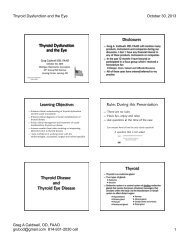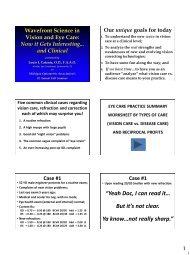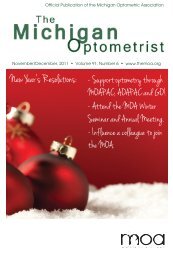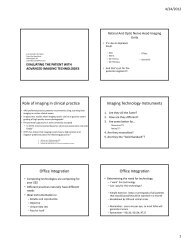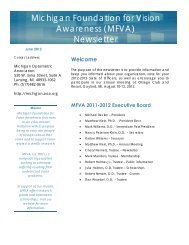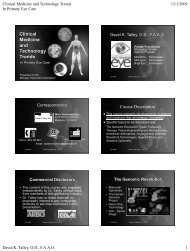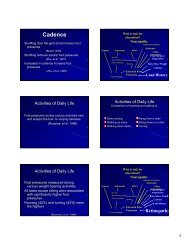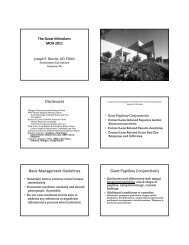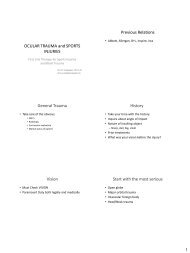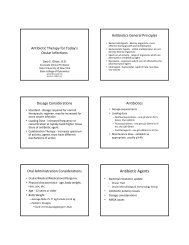Nutraceuticals, Supplements & Vitamins - Michigan Optometric ...
Nutraceuticals, Supplements & Vitamins - Michigan Optometric ...
Nutraceuticals, Supplements & Vitamins - Michigan Optometric ...
Create successful ePaper yourself
Turn your PDF publications into a flip-book with our unique Google optimized e-Paper software.
<strong>Nutraceuticals</strong>, <strong>Supplements</strong> &<br />
<strong>Vitamins</strong> in Eye Care<br />
Gary E. Oliver, O.D.<br />
Associate Clinical Professor<br />
State University of New York<br />
State College of Optometry<br />
geoliver.od@att.net<br />
goliver@sunyopt.edu<br />
General Population Data<br />
• Literature confirms that good nutrition in<br />
general helps improve:<br />
• Stem cell activity<br />
• WBC activity<br />
• Healing processes<br />
• Proper gene expression<br />
Antioxidant-rich vitamin/mineral<br />
supplements<br />
• Be aware that most "one-a-day" vitamins,<br />
usually contain water-soluble vitamin C and Bcomplex<br />
vitamins which are excreted just 12<br />
hours after ingestion.<br />
• Ideally want supplements rich in amino acid<br />
chelates. This enhances bioavailability and<br />
reduces the side effects when combined with<br />
ionic salt forms of the minerals.<br />
General Population Data<br />
• 42% use complementary & alternative<br />
medicines, mostly vitamins<br />
• 5.4% of glaucoma patients use alternative<br />
medications<br />
• 8% use herbal medicines<br />
Some Side Effects Examples<br />
• General population usually not aware of some<br />
of the side effects<br />
• Excess vitamin D can affect bone metabolism<br />
• High doses of vitamin A can cause birth<br />
defects in pregnant women<br />
• Blood thinning effects of vitamin E<br />
Clinical Indications<br />
• Evidence may still be stronger for prophylactic<br />
than therapeutic usage<br />
• Antioxidant formulas – most common<br />
• Clinical Applications<br />
1
Age Related Macular Degeneration<br />
Age Related Macular Degeneration<br />
Pathophysiology<br />
– Reactive oxygen, generated through photo-oxidation and<br />
normal metabolic processes, likely contribute to<br />
degeneration<br />
– Accumulation of lipofucion pigment enhances the<br />
phototoxicity effects<br />
– Free radical formation following exposure to ionizing<br />
radiation, UV light, or visible light can enhance lipid perioxidation<br />
of the photoreceptor outer-segment<br />
membranes, which are rich in polyunsaturated fatty<br />
acids<br />
Age Related Macular Degeneration<br />
Epidemiological Studies<br />
– Observational studies have shown that<br />
individuals who have higher intake of<br />
antioxidant nutrients have decreased risks of<br />
ARMD<br />
– Beaver Dam Eye Study - large drusen formation<br />
reduced with intake of pro-vitamin carotenoids<br />
and vitamin E, higher intake of zinc associated<br />
with a decreased incidence of retinal pigmentary<br />
abnormalities<br />
Age Related Macular Degeneration<br />
Randomized Trials and Other Studies<br />
– Oral Zinc in Macular Degeneration - small pilot<br />
study, 174 patients randomly received 80 mg<br />
zinc or placebo, less visual acuity loss with zinc<br />
intake, study concluded early due to concerns<br />
about zinc toxicity and incidence of ARMD in<br />
untreated group unusually high<br />
– Multicenter Ophthalmic and Nutritional ARMD<br />
Study - stabilization of ARMD with broad<br />
spectrum antioxidant formula, possible<br />
increases in visual function<br />
Age Related Macular Degeneration<br />
– Complex disorder involving genetic, cardiovascular, and<br />
environmental factors<br />
– Risk factors include age, ethnicity, gender, genetics,<br />
cardiovascular disease, smoking and sun exposure<br />
– Cumulative oxidative stress may contribute to apoptosis of<br />
the photoreceptors<br />
– Oxidation, inflammation, neovascularization result<br />
– Decreased xanthophylls, vitamin E and other antioxidant<br />
intake emerging as key nutritional factors<br />
Age Related Macular Degeneration<br />
– Physicians Health Study I - men taking vitamin E<br />
supplements had 13% reduced risk of ARMD,<br />
multivitamin supplements resulted in 10%<br />
reduced risk, no reduced risk associated with<br />
vitamin C supplements<br />
Age Related Macular Degeneration<br />
Age Related Eye Disease Study (AREDS) – broad<br />
based clinical trial looking at antioxidant & vitamin<br />
supplementation intake on age related macular<br />
degeneration<br />
Lutein Antioxidant Supplementation Trial (LAST) –<br />
clinical trial studied lutein supplementation and<br />
lutein with antioxidants supplementation<br />
LAST II – clinical trial to determine which<br />
patients benefit the most<br />
2
Age Related Macular Degeneration<br />
Taurine, Omega-3 fatty acid, Zinc, Antioxidant,<br />
Lutein Study (TOZAL) – trial examined effects<br />
of omega-3 fatty acids and other nutrients on<br />
reducing the progression of ARMD<br />
Nutritional <strong>Supplements</strong> for Prevention<br />
of ARMD<br />
Carotenoids<br />
• Lutein - primary macular pigment with antioxidant<br />
activity, increased intake (10-30 mg/day) increases<br />
accumulation in macula<br />
– Some studies found 6 mg/day initially, 2 mg/day<br />
maintenance reduced risk<br />
– More recent study – no increase in MPOD with 6<br />
mg/day lutein, need at least 10 mg<br />
• Zeaxanthin - primary macular pigment with antioxidant<br />
activity, increased intake (2-6 mg/day) increases<br />
accumulation in macula<br />
• Elevated intakes reduce risks of ARMD<br />
• Yellow xanthophyll plant pigments<br />
Nutritional <strong>Supplements</strong> for Prevention of<br />
ARMD<br />
• Macular pigment decreased in smokers,<br />
females > males, light color iris<br />
• Macular pigment may result directly from<br />
dietary origins with healthy and diseased<br />
macula capable of accumulating and<br />
stabilizing both lutein and zeaxanthin<br />
Age Related Macular Degeneration<br />
• Age Related Eye Disease Study 2 (AREDS 2) – broad<br />
based study similar design to AREDS to investigate<br />
effects of lutein, zeaxanthin and omega-3 fatty acid<br />
(EPA, DHA) supplementation on ARMD disease<br />
progression<br />
• Patients with intermediate or advanced ARMD<br />
• AREDS 2 to refine original AREDS formula<br />
• AREDS 2 to assess the effects of reducing zinc and<br />
eliminating beta-carotene on progression of ARMD<br />
Nutritional <strong>Supplements</strong> for Prevention<br />
of ARMD<br />
• Lutein - concentrated in the macula lutea, acts as<br />
antioxidant, also found in the aqueous<br />
• Zeaxanthin - primary macular pigment, acts as<br />
antioxidant, predominant pigment in central fovea<br />
• Zeaxanthin – 11 double bonds compared to 10 for<br />
lutein, possibly greater protection against blue and<br />
near ultraviolet light<br />
• Pigments also found in inner layers of retina, may<br />
protect against photo-induced (blue light) retinal<br />
damage, increased pigment concentrations<br />
associated with higher visual sensitivity<br />
Nutritional <strong>Supplements</strong> for Prevention of<br />
ARMD<br />
Lutein Antioxidant Supplementation Trial<br />
• 15mg lutein, 20 mg vitamin E<br />
• Positive effect on macular function<br />
AREDS Report 22 – Higher dietary intake of<br />
lutein/zeaxanthin independently associated with<br />
decreased likelihood of having neovascular ARMD,<br />
geographic atrophy, and large or extensive<br />
intermediate drusen<br />
3
Nutritional <strong>Supplements</strong> for Prevention of<br />
ARMD<br />
• CAREDS<br />
– diets rich in lutein plus zeaxanthin may protect<br />
against intermediate ARMD in healthy women<br />
younger than 75 years of age<br />
Nutritional <strong>Supplements</strong> for Prevention of<br />
ARMD<br />
Beta Carotene, Retinols<br />
• Beta carotene not found in significant amounts in the<br />
eye but still important in rod photo-physiology, binds<br />
with protein opsin in rods to form rhodopsin<br />
• Retinol essential for proper wound healing and<br />
immune function<br />
• Important for goblet cell metabolism and production<br />
of mucins in tear film<br />
• No significant benefits for prevention of ARMD by<br />
itself<br />
• High levels linked to increased incidence of lung<br />
cancer in heavy smokers<br />
Nutritional <strong>Supplements</strong> for Prevention of<br />
ARMD<br />
• Omega 3 supplementation eicosapentaenoic acid<br />
(EPA)<br />
• Believed to regulate levels of Omega 6 amino acid<br />
• Omega 6 implicated in abnormal retinal<br />
neovascularization, vascular permeability, and retinal<br />
inflammation<br />
• EPA also depresses VEGF receptor activation and<br />
expression<br />
Nutritional <strong>Supplements</strong> for Prevention of<br />
ARMD<br />
Lycopene<br />
– Strong antioxidant activity<br />
– Protective effect against aging of retinal pigment<br />
epithelial cells<br />
– Although not involved in macula, found in high<br />
concentrations in the ciliary body and RPE<br />
Nutritional <strong>Supplements</strong> for Prevention of<br />
ARMD<br />
• Omega 3 supplementation docosahexaenoic acid<br />
(DHA) 500 mg/day may improve cell biogenesis and<br />
neuronal signaling<br />
• Major component of retinal photoreceptors outer<br />
segment membranes<br />
• Synaptic membranes and photoreceptors have<br />
highest concentration of DHA<br />
• DHA (docosahexaenoic acid) - concentrated in<br />
phospholipids of retina and brain<br />
Nutritional <strong>Supplements</strong> for Prevention of<br />
ARMD<br />
• AREDS researchers surveyed subjects on dietary<br />
components<br />
• Subjects with the highest levels of omega-3 fatty acid<br />
intake had decreased risk of neovascular ARMD<br />
• Those with higher levels of serum vitamin D less<br />
likely to develop early dry ARMD<br />
4
Nutritional <strong>Supplements</strong> for Prevention of<br />
ARMD<br />
• TOZAL Study<br />
• Vision stabilized or improved in 67% of patients who<br />
used nutritional supplements with omega-3 fatty<br />
acids and antioxidants<br />
Nutritional <strong>Supplements</strong> for Prevention<br />
of ARMD<br />
<strong>Vitamins</strong><br />
• Vitamin E 400 IU/day<br />
– May protect retina from oxidative damage due<br />
to excessive sunlight exposure<br />
• Vitamin C 200-1,000 mg/day<br />
– Antioxidant and anti-inflammatory properties,<br />
questionable as single agent for prevention of<br />
ARMD<br />
– May improve synergy of antioxidants<br />
Nutritional <strong>Supplements</strong> for Prevention of<br />
ARMD<br />
<strong>Vitamins</strong><br />
• Vitamin D - patients with higher levels of serum<br />
vitamin D appear less likely to develop early dry<br />
ARMD<br />
• Vitamin D early data 200-400 IU for younger and<br />
older adults respectively, today higher amounts<br />
considered important 2,500-4,000 IU to increase<br />
blood serum levels<br />
• 2,000 IU daily increases anti-inflammatory cytokine<br />
IL-10 and decreases pro-inflammatory TNF-alpha<br />
• Suppresses retinal neovascularization in mouse<br />
model<br />
Nutritional <strong>Supplements</strong> for Prevention<br />
of ARMD<br />
Minerals<br />
• Zinc 25-50 mg/day (typically 25-30 mg/day) -<br />
reduced rate of visual acuity loss, no benefit or<br />
protection of the fellow eye in patients with<br />
choroidal neovascularizaiton in one eye<br />
• Monomethionine zinc is the most bioavailable<br />
form, only form that does not interfere with copper<br />
• Zinc toxicity associated with genitourinary and<br />
gastrointestinal disorders<br />
Nutritional <strong>Supplements</strong> for Prevention of<br />
ARMD<br />
<strong>Vitamins</strong><br />
• B-Complex vitamins (B6, B12, folate)<br />
• Helps keep homocysteine levels within a normal<br />
range<br />
• Elevated plasma homocysteine levels associated with<br />
exudative neovascular ARMD<br />
• Should always be taken together as a complex<br />
Nutritional <strong>Supplements</strong> for Prevention of<br />
ARMD<br />
• Lowers the risk for some cancers including breast,<br />
prostate and colon<br />
• May also lower blood pressure in hypertensive<br />
patients<br />
• Improves bone calcium absorption which also lowers<br />
amount of calcium plaques<br />
5
Nutritional <strong>Supplements</strong> for Prevention of<br />
ARMD<br />
Age Related Eye Disease<br />
Study (AREDS)<br />
• Antioxidant formula – daily<br />
• 500 mg vitamin C<br />
• 400 IU vitamin E<br />
• 25,000 IU beta carotene<br />
• 80 mg zinc oxide<br />
• 2 mg copper oxide<br />
AREDS 10 Yr Results<br />
Those patients with extensive intermediate size<br />
drusen, at least 1 large drusen, noncentral<br />
geographic atrophy in 1 or both eyes, or<br />
advanced AMD or vision loss due to AMD in 1<br />
eye and without contraindications such as<br />
smoking, should consider taking a supplement<br />
of antioxidants plus zinc such as that used in<br />
the AREDS study.<br />
AREDS 10 Yr Results<br />
• Persons who smoke are at increased risk for<br />
both ARMD and lung cancer.<br />
• Results from 2 other randomized clinical trials<br />
suggested increased risk of mortality among<br />
smokers supplementing with beta carotene.<br />
• Prudent for smokers to avoid taking beta<br />
carotene.<br />
AREDS 10 Yr Results<br />
Patients taking antioxidants alone or zinc alone<br />
reduced their risk by 17% and 21%<br />
respectively.<br />
Patients taking antioxidants plus zinc reduced<br />
their risk by 25%.<br />
AREDS 10 Yr Results<br />
• Studies using similar doses of beta carotene in<br />
persons at high risk for lung cancer (cigarette<br />
smokers and asbestos workers) have<br />
demonstrated an increased incidence of<br />
cancer and mortality.<br />
ARMD Categories<br />
• Category 1 – no ARMD, fewer than five small drusen<br />
(less than 63 um), visual acuity 20/30 or better in<br />
both eyes<br />
• Category 2 – mild ARMD, multiple small drusen or<br />
medium drusen (63-124um) in one/both eyes or RPE<br />
abnormalities, visual acuity 20/30 or better in both<br />
eyes<br />
6
ARMD Categories<br />
• Category 3 – at least one eye with visual acuity of<br />
20/30 or better with at least one large drusen<br />
(125um or greater), extensive intermediate drusen,<br />
absence of geographic RPE changes in center of<br />
macula or any combination<br />
• Category 4 – advanced ARMD or visual acuity less<br />
than 20/30 in one eye with the degenerative changes<br />
as the cause of the reduced vision, fellow eye visual<br />
acuity 20/30 or better<br />
Patient Criteria for AREDS Antioxidant<br />
<strong>Supplements</strong><br />
• Extensive intermediate size drusen (63um to 125um)<br />
• At least 1 large drusen (greater than 125um)<br />
• Noncentral geographic atrophy in one or both eyes<br />
• Advanced AMD or vision loss due to AMD in one eye<br />
• No contraindications such as smoking<br />
Age Related Cataracts<br />
• Ultraviolet light (particularly UVB) and<br />
oxidative stress may lead to development<br />
Patient Criteria for Lutein/Antioxidant<br />
<strong>Supplements</strong><br />
• At risk patients<br />
• Pigmentary abnormalities<br />
• Pigment changes with few small drusen<br />
• Extensive small drusen (less than 63um)<br />
• One or few intermediate size drusen (less than<br />
125um)<br />
Retinitis Pigmentosa<br />
Clinical Trials<br />
– Randomized clinical trial over 4-6 year period<br />
– 15,000 IU vitamin A (retinal palmitate<br />
formulation) beneficial in preserving vision<br />
– 400 IU vitamin E detrimental<br />
– Slower rate of decline in cone ERG amplitudes<br />
and visual field changes<br />
– All groups had 1 letter loss of vision per year<br />
– Recent study also found that 12 mg lutein daily<br />
further slowed mid-peripheral visual field loss in<br />
patients taking vitamin A<br />
Age Related Cataracts<br />
Antioxidant formulations with Vitamin C, E & beta<br />
carotene investigated<br />
AREDS – initial analysis little benefit<br />
Physicians Health Study I - randomized clinical trial looked at<br />
incidence of age related cataracts in physicians found no<br />
overall benefit, did reduce risk in smokers by 25%<br />
Roche European American Cataract Trial (REACT) –<br />
showed decreased cataract progression using similar beta<br />
carotene formula, earlier treatment with higher dosage<br />
compared to physician study, more sensitive measurement<br />
techniques<br />
7
Age Related Cataracts<br />
• Observational data from AREDS suggest that<br />
use of multivitamin may delay the progression<br />
of lens opacities<br />
• NEI Trial studying use of Centrum and cataract<br />
development<br />
Age Related Cataracts<br />
• Vitamin E may protect against UVB light<br />
induced cataract<br />
• Journal of Nutrition study found that<br />
xanthophyll carotenoids, lutein and zeaxanthin<br />
were more protective than Vitamin E<br />
Age Related Cataracts<br />
• Journal of Cataract and Refractive Surgery<br />
published a study which demonstrated that<br />
grape seed pranthocyanidin supplements<br />
suppressed experimental cataracts in animal<br />
model<br />
Age Related Cataracts<br />
High dose Vitamin C Supplementation Study<br />
– may have benefits, reduced risk of cataracts by 60% after<br />
10 years of supplementation<br />
– reduced risk of cortical cataracts in women under 60 years<br />
of age<br />
Increased total vitamin A - including carotenoids, and<br />
lutein/zeaxanthin consumption may reduce overall risk for<br />
cataract extraction<br />
Age Related Cataracts<br />
• One study indicates taking a broad based<br />
multivitamin supplement may reduce cataract<br />
risk by 33%<br />
• Another study found that patients taking<br />
regular doses of Vitamin E and maintained<br />
high blood levels reduced risk by 50%<br />
Age Related Cataracts<br />
• The Longitudinal Study of Cataract – reduction<br />
in nuclear cataract development with users of<br />
multivitamins or vitamin E separately<br />
• Lycopene - nutritional antioxidant, reduced<br />
incidence of nuclear cataract in animal model with<br />
restoration of normal lens physiology<br />
• EPA omega-3 - essential fatty acid found in the<br />
lens, supplementation may help maintain clarity<br />
8
Diabetic Cataracts<br />
• Bioflavonoids – bilberry, quercetin and its<br />
derivatives help inhibit aldose reductase<br />
Diabetic Retinopathy<br />
• Lower levels of antioxidants in diabetic patients<br />
• Diabetes induced oxidative damage and nitrative<br />
stress in eyes with diabetic retinopathy<br />
• Study demonstrated that zeaxanthin<br />
supplementation may prevent the damage<br />
Optic Nerve Abnomalities<br />
• Study reported at ARVO<br />
• Folic acid, B6 and B12 may enhance growth<br />
and possibly repair damaged mechanisms in<br />
the adult central nervous system<br />
• Previously known that supplementation<br />
helped neuronal tube development in embryo<br />
Diabetic Neuropathy<br />
• Alpha-lipoic acid 100-300 mg day - mimics<br />
antioxidants may reduce frequency and symptoms of<br />
diabetic neuropathy<br />
• ? Benefits for diabetic cataract<br />
Optic Nerve Abnomalities<br />
Nutritional Amblyopia and Tobacco Alcohol<br />
Amblyopia<br />
• B-complex vitamins formulations have been<br />
shown to have therapeutic effects<br />
• B-complex formulations – B-6, B-12, niacin,<br />
folic acid<br />
• Therapeutic benefits possible by reestablishing<br />
healthy metabolism<br />
Glaucoma<br />
Gingko Biloba<br />
• NMDA blocker (N-methyl-D-aspartate) -<br />
neuroprotective activity<br />
Actions<br />
• Physiological actions - increases blood flow to<br />
neurological tissues<br />
• Antioxidant activity, increased platelet activating<br />
factor, nitric oxide inhibition<br />
• May result in neuroprotection of retinal ganglion<br />
cells in glaucoma<br />
9
Glaucoma<br />
• Gingko Biloba<br />
Improves blood flow to optic nerve<br />
Reduces blood serum viscosity<br />
Antioxidant activity<br />
Increases platelet activating factor activity<br />
Inhibition of apoptosis<br />
Inhibition of excitotoxicity<br />
Dry Eye Syndrome<br />
• More women than men have dry eye<br />
• Androgen deficiency may lead to meibomian<br />
gland dysfunction<br />
• Androgen deficiency and estrogen<br />
replacement therapy may increase ocular<br />
surface inflammation<br />
Nutritional Alternatives<br />
• Omega 3 essential fatty acid sources<br />
• Flaxseed oil – alpha-linolenic acid omega 3 (57%),<br />
linolenic acid omega 6 (15%), oleic acid omega 9<br />
(18%)<br />
• Other plant derived omega 3 fatty acid – gamma<br />
linolenic acid (GLA)<br />
• Fish oil – rich in omega 3 EPA & DHA essential fatty<br />
acids (sardines), most products have 1.5 EPA to 1<br />
DHA ratio<br />
• Be careful of fish oil quality. Needs to be free of or<br />
have acceptable levels of mercury or other toxins.<br />
Glaucoma<br />
• Ginkgo Biloba<br />
One study indicated increased end diastolic velocity<br />
within optic nerve with no effects on arterial<br />
blood pressure, heart rate, or IOP<br />
Another study found improvement of pre-existing<br />
VF defects in normal tension glaucoma patients<br />
Dosage in both studies was 40mg tid / day<br />
Dry Eye Syndrome<br />
• Omega 3 supplementation beneficial<br />
• Recent study at Brigham and Women’s<br />
Hospital found that improving the ratios of<br />
omega 3 fatty acids to omega 6 fatty acids<br />
improved dry eye syndrome in women<br />
• Opposite made it worse<br />
Nutritional Alternatives<br />
• Depending on formulation, need 1,000-2,000 mg<br />
omega 3 essential fatty acids per day to have<br />
therapeutic effect<br />
• Stimulate tear production, rebalance tear film<br />
physiology and improve meibomian gland secretion<br />
quality<br />
• No benefits in drug induced dry eye syndrome<br />
10
Omega 3 Fatty Acids<br />
• Sjogren's patients tend to have lower dietary levels<br />
of omega-3 fatty acids, including EPA & DHA than<br />
matched controls<br />
• Optimum ratio of omega-3 to omega-6 ratio for good<br />
health typically is 1:4<br />
• Severity of dry eye in Sjogren's syndrome is inversely<br />
proportional to membrane and serum levels of DHA<br />
• Omega 3 fatty acids affect the lipid profiles of<br />
meibomian gland secretions in Sjogren’s patients<br />
Dry Eye Syndrome<br />
Gamma-linoleic acid (GLA) may be beneficial in<br />
Sjogren’s syndrome<br />
Diets with proper levels of <strong>Vitamins</strong> A, B6, C;<br />
potassium; zinc also important for normal tear film<br />
function<br />
Potassium – improves tear film osmolarity (TheraTears<br />
artificial tear formulation)<br />
Albumin – ocular surface disorders with tear deficiency<br />
Omega 3 Fatty Acids<br />
• Omega-3 fatty acids help suppress meibomianitis,<br />
decrease apoptosis, improve neural signal<br />
transduction, stimulate tear production, augment<br />
the tear film oily layer and have anti-inflammatory<br />
properties<br />
• Increased essential fatty acids, particularly omega 3<br />
stimulates tear production and rebalances tear film<br />
physiology<br />
• May also benefit acne rosacea patients with<br />
associated dry eye syndrome<br />
Contact Lens Related Infections<br />
• Contact lens biofilms may be associated with low<br />
levels of tear lactoferrin<br />
• Hydroxyl radicals, a by-product of oxidative stress<br />
superoxide and H2O2 catalyzed by free iron, may<br />
exacerbate damage to cornea<br />
• Adequate levels of iron-binding tear lactoferrin is<br />
suggested to lower corneal opportunistic risks for<br />
related infections.<br />
• Site-specific lactoferrin proteins are also<br />
produced and immediately released by neutrophils,<br />
the first white blood cells to appear in infection<br />
11



